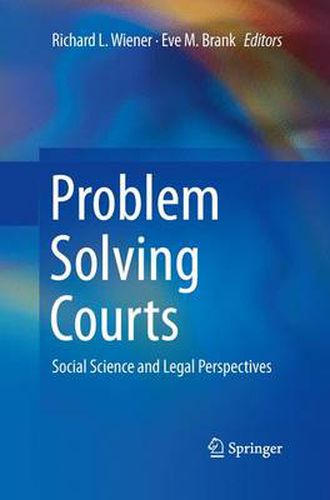Readings Newsletter
Become a Readings Member to make your shopping experience even easier.
Sign in or sign up for free!
You’re not far away from qualifying for FREE standard shipping within Australia
You’ve qualified for FREE standard shipping within Australia
The cart is loading…






This title is printed to order. This book may have been self-published. If so, we cannot guarantee the quality of the content. In the main most books will have gone through the editing process however some may not. We therefore suggest that you be aware of this before ordering this book. If in doubt check either the author or publisher’s details as we are unable to accept any returns unless they are faulty. Please contact us if you have any questions.
In order to make the criminal court system more effective there has been a growing trend to have courts participate in what is essentially a rehabilitation strategy. Such courts are often referred to as problem-solving because they are working on root causes of criminal behavior as part of the dispensation of justice. This major shift in the role of the courts means that the court works closely with prosecutors, public defenders, probation officers, social workers, and other justice system partners to develop a strategy that pressures offenders to complete a treatment program which will ultimately, hopefully prevent recidivism. Research has shown that this kind of strategy has a two-fold benefit. It has been successful in helping offenders turn their lives around which leads to improved public safety and the ultimate saving of public funds. This book is the first to focus exclusively on problem solving courts, and as such it presents an overview of the rationale and scientific evidence for such courts as well as individual sections on the key areas in which these courts are active. Thus there is specific attention paid to domestic violence, juvenile criminality, mental health, and more. Throughout, research findings are incorporated into general discussions of these courts operate and ideally what they are trying to accomplish. There is also discussion of how such courts should evolve in the future and the directions that further research should take.
$9.00 standard shipping within Australia
FREE standard shipping within Australia for orders over $100.00
Express & International shipping calculated at checkout
This title is printed to order. This book may have been self-published. If so, we cannot guarantee the quality of the content. In the main most books will have gone through the editing process however some may not. We therefore suggest that you be aware of this before ordering this book. If in doubt check either the author or publisher’s details as we are unable to accept any returns unless they are faulty. Please contact us if you have any questions.
In order to make the criminal court system more effective there has been a growing trend to have courts participate in what is essentially a rehabilitation strategy. Such courts are often referred to as problem-solving because they are working on root causes of criminal behavior as part of the dispensation of justice. This major shift in the role of the courts means that the court works closely with prosecutors, public defenders, probation officers, social workers, and other justice system partners to develop a strategy that pressures offenders to complete a treatment program which will ultimately, hopefully prevent recidivism. Research has shown that this kind of strategy has a two-fold benefit. It has been successful in helping offenders turn their lives around which leads to improved public safety and the ultimate saving of public funds. This book is the first to focus exclusively on problem solving courts, and as such it presents an overview of the rationale and scientific evidence for such courts as well as individual sections on the key areas in which these courts are active. Thus there is specific attention paid to domestic violence, juvenile criminality, mental health, and more. Throughout, research findings are incorporated into general discussions of these courts operate and ideally what they are trying to accomplish. There is also discussion of how such courts should evolve in the future and the directions that further research should take.